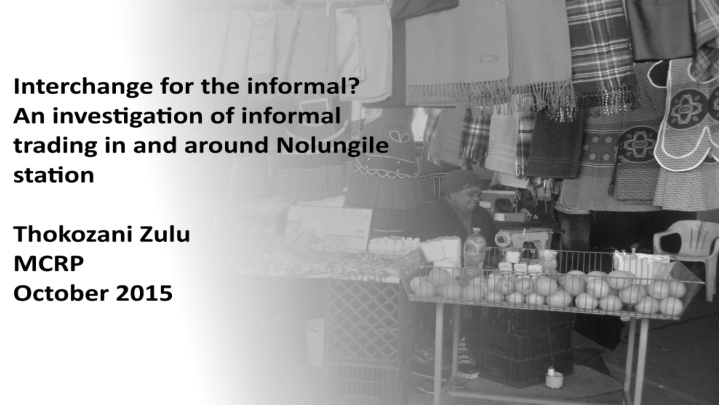



1,7 ,7 bil illion people work in in the in informal economy Contribution of informal economy to GDP ( source: Jutting & De Laiglesia, 2009 )
StatsSA definition • Employees working in establishments that employ less than five employees, who do not deduct income tax from their salaries/wages; and; • Employers, own-account workers and persons helping unpaid in their household business who are not registered for either income tax or value-added tax (ICLS, 1993). • Dominated by black South Africans (Vanek et al. 2014) • Trade dominant industry (Skinner, 2013)
SA In Informal Sector: By In Industry ry Finance Other Manufacturing 6% 0% 9% Transport Trade 10% 46% Construction Community and 14% Social Services 15%
Problem under study • Very little information on informal trading in townships • T ownship economy hasn’t been examined in much detail with regards to the relationships traders have with management that own the transport interchanges in which they trade • Effects infrastructure projects have on informal traders
The aim of f the research Thus this paper’s aim is to better understand the dynamics of informal trade in townships especially that which happen at transport interchanges
Main in research questions • Understanding the day to day operations of the informal traders and how different trades use space differently . • Understanding the processes that enable/disable workers and operators in the informal economy to have sustainable livelihoods. • Looking at policy and management, and what is said about the informal economy. • Looking at principles of firms (PRASA and DesignSpaceAfrica) and whether they acknowledge the informal traders and have made provisions for them. • Investigating whether the new stations/station upgrades will reduce the vulnerability of informal economic actors by enhancing their access to facilities, services, markets and other resources.
Research methods and techniques • Case study method • Observation techniques • Purposive sampling trader interviews • Key informant interviews • Documentary evidence • Questionnaire
Research Fin indings • There is a variety of goods that are found in the site C area, these are: consumables, fruit, cosmetics, jewellery, prefabricated shack components, clothing, fast food, meat centre, hair salon, and cellphone repair shop, etc. • Two distinctive trading patterns found which constitutes of a small number of traders trading on the inside, and the rest of the traders who trade outside the station • The different types of trading all group together (the people who sell meat are together, and the sewers are together, etc.), resembling slight niche markets • Sale of products is reliant on passing feet, thus foot movement is an important factor in trading
Trading areas
Age and sex of f informal traders Sex variation at Nolungile Age variation at Nolungile 14 9 8 12 7 10 6 0-16 8 17-24 5 AMOUNT AMOUNT 25-34 Male 4 35-44 6 Female 45-54 3 55-64 4 n= 23 65+ 2 2 n= 23 1 0 0 inside station outside station Inside Outside TRADERS TRADERS
Aspects of f business Number of years trading Reasons for trading 25-30 yrs 17% 21-25 yrs 26% 16-20 yrs AMOUNT OF YEARS Make more money Support family 11-15 yrs Outside Be an entrepreneur Inside Couldn't find a job 6-10 yrs Family business 26% 2-5 yrs n=23 17% n=23 0-1 yrs 14% 0 1 2 3 4 5 6 7 8 NUMBER OF PEOPLE
Aspects of f business Ownership of businesses Types of trading at site C 4% Own account with employees 9% Sewing 4% 31% Accessories TYPES OF OWNERSHIP Vetkoek Cellphone repair 9% Partnerships Outside Consumables Inside Fruits Clothing Medicine 4% n=19 Meat 18% Own account worker Cosmetics 4% 4% n=23 13% 0 1 2 3 4 5 6 7 8 AMOUNT
Rentals, , services, shelter and storage
Relations with support and governance institutions • Traders have no knowledge of area manager or department that manages site C area • Belong to UKITA, a Non-profit trader organisation which City of Cape Town helped launch • City of Cape Town offloading duties to UKITA • PRASA manages the inside of the station
PRASA modernisation project The goal is to “turn stations into profitable commercial hubs, thus generating greater revenue, keeping commuter prices down and enabling the agency to create a better service…if you have 145 000 people passing through the station, and if you’re involved in retail and selling foodstuff, it's the right place to be.” (Lucky Montana, 2013)
PRASA modernisation project “We haven’t had a really good experience with them (PRASA). They have tried to move us in 2008/2009 and we refused to go because we have been here for years. Then they tried to move us again in 2012 and we went to our ward councillor Mr. Maphuma for help. We had talks with them which resulted in what you see now, the 1x1m trading squares created for 16 people, and being moved to the other side of the station. Some people even moved because of this,” (2/9/2015).
Recommendations Adding designated Activating trading and creating spaces lively public spaces for communities and traders alike
Recommendations • Initiating and sustaining a comprehensive participation processes • Establishment of responsible and accountable management • Reconsideration of PRASA’s approach to station upgrades • Initiation of support programs • Increased legal awareness • Development of a local area plan
THANK YOU!
Recommend
More recommend